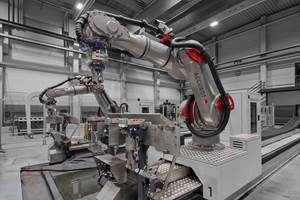SpaceX crew capsule returns to Earth after successful flight test
The SpaceX Crew Dragon successfully parachuted to Earth on March 8, 2019, marking the end of Demo-1, NASA’s first commercial crew flight test.
SpaceX’s (Hawthorne, Calif., U.S.) Crew Dragon spacecraft returned to Earth today after a five-day mission docked to the International Space Station. According to NASA, about six hours after departing the space station, Crew Dragon splashed down at 8:45 a.m. EST, approximately 230 miles off the coast of Cape Canaveral, Fla., U.S. SpaceX retrieved the spacecraft from the Atlantic Ocean and is transporting it back to port on the company’s recovery ship.
Demonstration Mission-1 (Demo-1) was an uncrewed flight test designed to demonstrate a new commercial capability developed under NASA’s Commercial Crew Program. The mission began March 2, when the Crew Dragon launched from NASA’s Kennedy Space Center in Florida, and racked up a number of “firsts” in less than a week:
- First commercially-built and operated American crew spacecraft and rocket to launch from American soil on a mission to the space station.
- First commercially-built and operated American crew spacecraft to dock with the space station.
- First autonomous docking of a U.S. spacecraft to the International Space Station.
- First use of a new, global design standard for the adapters that connect the space station and Crew Dragon, and also will be used for the Orion spacecraft for NASA’s future mission to the Moon.
See CW’s coverage of the launch of Crew Dragon aboard the Falcon 9 rocket.
NASA and SpaceX teams gathered in the early morning hours at the company’s headquarters in Hawthorne, Calif. U.S., to follow the spacecraft’s return journey and ocean splashdown.
Demo-1 was a critical step in validating the performance of SpaceX’s systems, and brought NASA a step closer to sending the first human astronauts to the space station from U.S. soil since the last shuttle mission in 2011. However, NASA and SpaceX still have work to do to validate the spacecraft’s performance and prepare it to fly astronauts.
On this flight test, Crew Dragon carried a lifelike test device named Ripley, which was outfitted with sensors to provide data about potential effects on humans traveling in the spacecraft. After SpaceX processes data from this mission, teams will begin refurbishing Crew Dragon for its next mission, an in-flight abort test targeted to take place this summer. Demo-2, the first crewed test flight, will carry NASA astronauts Bob Behnken and Doug Hurley on the spacecraft’s final flight to certify Crew Dragon for routine operational missions.
“If you just think about the enormity of this flight and all of the prep that went into it – getting the pad refurbished, getting the flight control room set up, getting the vehicle built, getting the Falcon 9 ready, all of the analysis and mission support that went into it – it’s just been a tremendous job. Our NASA and SpaceX teams worked seamlessly not only in the lead-up to the flight but in how we managed the flight,” says Steve Stich, deputy manager of NASA’s Commercial Crew Program.
“For the first time, we’ve gotten to see an end-to-end test, and so now we’ve brought together the people, the hardware and all the processes and procedures, and we’ve gotten to see how they all work together, and that’s very important as we move toward putting people onboard,” says NASA astronaut Mike Hopkins, who will crew SpaceX’s first operational mission to the space station following Demo-2. “I’m, personally, very anxious to hear how Ripley is feeling after they pull her out of the capsule and get her onto the recovery vehicle.”
Related Content
Plant tour: Collins Aerospace, Riverside, Calif., U.S. and Almere, Netherlands
Composite Tier 1’s long history, acquisition of stamped parts pioneer Dutch Thermoplastic Components, advances roadmap for growth in thermoplastic composite parts.
Read MorePlant tour: Aernnova Composites, Toledo and Illescas, Spain
RTM and ATL/AFP high-rate production sites feature this composites and engineering leader’s continued push for excellence and innovation for future airframes.
Read MoreFirst Airbus A350 crash confirmed in Haneda
Shortly after touch-down, a JAL A350-900 aircraft recently collided with a De Havilland Canada Dash 8. Exact circumstances are still unknown.
Read MoreAutomated robotic NDT enhances capabilities for composites
Kineco Kaman Composites India uses a bespoke Fill Accubot ultrasonic testing system to boost inspection efficiency and productivity.
Read MoreRead Next
Next-gen fan blades: Hybrid twin RTM, printed sensors, laser shock disassembly
MORPHO project demonstrates blade with 20% faster RTM cure cycle, uses AI-based monitoring for improved maintenance/life cycle management and proves laser shock disassembly for recycling.
Read MoreCutting 100 pounds, certification time for the X-59 nose cone
Swift Engineering used HyperX software to remove 100 pounds from 38-foot graphite/epoxy cored nose cone for X-59 supersonic aircraft.
Read MoreScaling up, optimizing the flax fiber composite camper
Greenlander’s Sherpa RV cab, which is largely constructed from flax fiber/bio-epoxy sandwich panels, nears commercial production readiness and next-generation scale-up.
Read More.jpg;width=70;height=70;mode=crop)












